
Introduction
Dell's UltraSharp monitor range has always
been very popular, and tend to offer very solid all-round performance, along with a
decent range of features and a good warranty and support package. We have with
us at the moment the latest update to the 27" UltraSharp range, the U2719D. This
supersedes the
U2717D which we reviewed back in June 2016. There are two versions of this
new model available, the standard U2719D and a model with an added USB type-C
connection which is the U2719DC. Both are otherwise identical so this review can
be considered for both versions. There's not been a massive range of updates to
the specs and features since the previous U2717D, apart from the new USB type-C
connection on the C model. It continues to have the very sleek and attractive 4
side borderless design and IPS-type panel with 1440p resolution. The stand has
been updated a bit, and DisplayPort has been updated to the latest v1.4 (not
that it's really needed to power this screen). We will of course make
comparisons to see if and how performance varies between the U2717D and the new
U2719D throughout this review.
If you
would like to help support our continued work please consider making a
donation
no matter how small or large. Thank you.

|
Check Pricing and Buy - Affiliate Links
|
|
Amazon
|
|
TFTCentral is a participant
in the Amazon Services LLC Associates Programme, an affiliate
advertising programme designed to provide a means for sites to earn
advertising fees by advertising and linking to Amazon.com, Amazon.co.uk,
Amazon.de, Amazon.ca and other Amazon stores worldwide. We also
participate in a similar scheme for Overclockers.co.uk. |

Specifications and
Features
The following table gives detailed
information about the specs of the screen as advertised:
|
Monitor
Specifications |
|
Size |
27" |
Panel Coating |
Light AG coating |
|
Aspect
Ratio |
16:9 flat |
Interfaces |
1x
DisplayPort 1.4
1x DisplayPort out
1x HDMI
4x USB 3.0 hub (2x with
fast charging)
1x audio line out
|
|
Resolution |
2560 x 1440 |
|
Pixel Pitch |
0.233mm |
Design
colour |
4 side borderless design
with matte black and silver plastics, and dark silver stand |
|
Response Time |
5ms G2G (fast)
8ms G2G (normal) |
Ergonomics |
Tilt, 130mm height, swivel, rotate |
|
Static Contrast Ratio |
1000:1 |
|
Dynamic Contrast Ratio |
n/a |
VESA Compatible |
Yes 100 x 100 mm |
|
Brightness |
350 cd/m2 |
Accessories |
DisplayPort, HDMI, USB
cables and power cables |
|
Viewing Angles |
178 / 178 |
|
Panel Technology |
Samsung PLS (IPS-type) |
Weight |
with stand: 6.64 Kg |
|
Backlight Technology |
W-LED |
Physical Dimensions |
(WxHxD) with stand
612 x 390 x 180 mm |
|
Colour Depth |
16.7m (8-bit) |
|
Refresh Rate |
60Hz |
Special
Features |
Factory calibration, audio
output |
|
Colour
Gamut |
Slightly wider than standard gamut 99.9% sRGB, 85% DCI-P3 (quoted) |
The U2719D offers a very good range of
connectivity with 1x DisplayPort 1.4, 1x DisplayPort out (for daisy chaining)
and 1 x HDMI offered
for video connections. For PC connectivity the DisplayPort is the most common
option, with HDMI being available then for connecting external games consoles or
Blu-ray players potentially.
There is an additional 4 port USB 3.0 hub, with two of the ports located
on the back of the screen and 2 on the left hand side for easy access. One port
in each pair has fast charging capabilities too. The screen has an internal
power supply and comes packaged with the standard kettle power cable you need. An
audio output
connection is provided as well for audio pass-through but there are no
integrated speakers.
Below is a summary of the features and
connections of the screen:
|
Feature |
Yes / No |
Feature |
Yes / No |
|
Tilt adjust |
 |
DVI |
 |
|
Height adjust |
 |
HDMI |
 |
|
Swivel adjust |
 |
D-sub |
 |
|
Rotate adjust |
 |
DisplayPort |
 |
|
VESA compliant |
 |
Component |
 |
|
USB 2.0 Ports |
 |
Audio connection |
 |
|
USB 3.0 Ports |
 |
HDCP Support |
 |
|
Card Reader |
 |
MHL Support |
 |
|
Ambient Light Sensor |
 |
Integrated Speakers |
 |
|
Human Motion Sensor |
 |
PiP / PbP |
 |
|
Touch Screen |
 |
Blur Reduction Mode |
 |
|
Factory calibration |
 |
NVIDIA G-Sync |
 |
|
Hardware calibration |
 |
AMD FreeSync |
 |
|
Uniformity correction |
 |
Meaningful HDR |
 |

Design and
Ergonomics

Above: front view of the screen
The U2719D comes in a black and dark grey
design with matte plastics used. This model has a very attractive 4-side
borderless design which looks really sleek, and makes it a very viable option
for multi-screen setups. There is a thin 1mm plastic edge around all 4 sides of
the screen and then an additional 6mm thick black panel border - giving a total
edge of only 7mm around all sides. There is a small silver Dell logo stuck along
the bottom panel border but no other labels or logos visible. The OSD control
buttons are located on the bottom right hand edge of the screen and are just out
of sight from a normal viewing position. There is also a power button which has
a very small white LED within it to show when the screen is on. Again this is
just out of sight from a normal viewing position we found. The arm and base of
the stand are finished in a matte dark silver colour and provide a simple, yet
sturdy base for the screen.

Above: rear views of the screen
The back of the screen is encased mostly in matte
silver plastic as you can see above. The stand attaches in the middle using a
quick release mechanism, but can be removed for VESA 100mm mounting if you want
too. There is a useful cable tidy hole in the back of the stand as well as you
can see above.

Above: side profile of the screen
The screen has a very thin side profile as shown in the picture above. This is despite it having an integrated
power supply (you only need a normal kettle lead to power the screen). On the
left hand bottom edge of the screen are 2x USB 3.0 ports, one with fast charging capabilities.
These supplement the 2 that are on the back of the screen with the video
connections and are very handy for easy access.

Above:
stand rotation adjustment
shown
There is a very good range of ergonomic
adjustments offered by the stand. Tilt offers a wide range and is smooth and
easy to
move. There is a 130mm height adjustment which is a bit stiff but smooth overall. At the lowest setting the bottom edge of the screen is
40mm from
the top of the desk, and 170mm when at maximum height extension. Side to side
swivel is provided and is smooth and easy. There's also a rotation function
which is (quite rarely) smooth and simple to move too, and you can even rotate
it in either direction (left or right) which is unusual. Overall a very
versatile stand.
A summary of the ergonomic adjustments are
shown below:
|
Function |
Range |
Smoothness |
Ease of
Use |
|
Tilt |
Yes |
Smooth |
Easy |
|
Height |
130mm |
Smooth |
Fairly stiff |
|
Swivel |
Yes |
Smooth |
Easy |
|
Rotate |
Yes |
Smooth |
Easy |
|
Overall |
Very good set of adjustments
and generally all easy enough to move. Sturdy and stable with minimal
wobble from the stand. |
The materials were of a good
standard and the build quality felt very good. There was no audible noise from the
screen, even when conducting specific tests which can often identify buzzing
issues. The whole screen remained cool even during prolonged use.

The back of the screen features the
connections. There are: 1. AC power
connector | 2. HDMI connector | 3. DP connector (in) | 4. DP connector (out) |
5. Audio line-out port | 6. USB upstream port | 7. USB downstream ports (x1
with Power Charging) | 8. Stand lock | 9. USB downstream Ports (x1 with Power
Charging)
The
OSD is controlled through 4 pressable buttons located on the bottom right hand
edge of the screen. By default there is quick launch access to the preset mode
and input selection menus, although these can be customised to other options
from within the main OSD if you want.
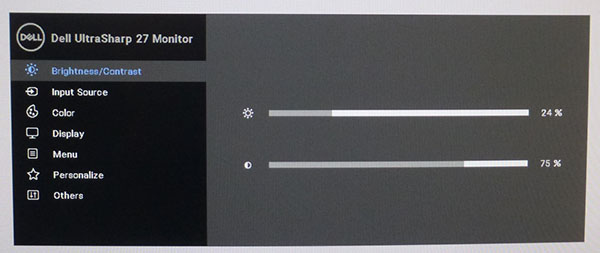
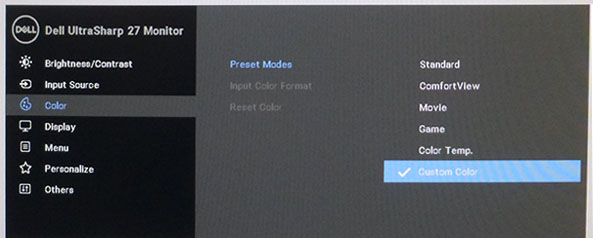
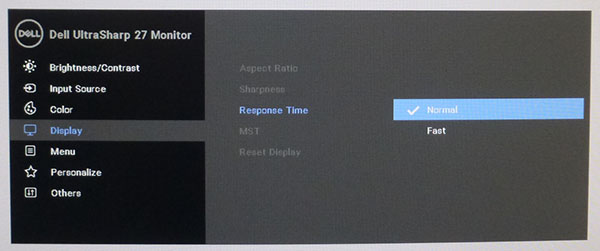
The
main OSD is split in to 7 sections down the left hand side, with the options
available in each shown on the right. There are all the usual settings to play
with, although colour controls felt a little limited. Navigation was quick and
easy and felt intuitive which was good news.

Power Consumption
In terms of power consumption the
manufacturer lists a usage of 30W and 0.3W in standby.
We carried out our normal tests to establish its power consumption ourselves.
|
 |
|
State and Brightness Setting |
Manufacturer Spec (W) |
Measured Power Usage (W) |
|
Default (75%) |
30.0 |
25.6 |
|
Calibrated (24%) |
- |
17.9 |
|
Maximum Brightness
(100%) |
- |
30.8 |
|
Minimum Brightness
(0%) |
- |
13.6 |
|
Standby |
0.3 |
0.6 |
|
Out of the box the screen used 25.6W at the
default 75% brightness setting. Once calibrated the screen reached
17.9W
consumption, and in standby it used only 0.6W. We have plotted these results
below compared with other screens we have tested. The consumption (comparing the
calibrated states) is comparable to the smaller 27 - 31.5" sized screens here.
It is less than the Asus ROG Swift PG27UQ, which while being the same 27" in
size, has a Full Array Local Dimming (FALD) backlight for HDR and so uses a lot
more power.


Panel and Backlighting
|
Panel Manufacturer |
Samsung |
Colour Palette |
16.7 million |
|
Panel Technology |
PLS (IPS-type) |
Colour Depth |
8-bit |
|
Panel Module |
W270HIAP1
(LTM270DL11) |
Colour space |
Slightly extended gamut |
|
Backlighting Type |
W-LED |
Colour space coverage (%) |
109% sRGB, 80% DCI-P3
measured |
|
|
Key
Quick Information Box
-
Samsung PLS technology panel (IPS-type)
-
8-bit
colour depth
-
Slightly wider than standard gamut at ~109% sRGB / 80% DCI-P3 but
not by much
-
Flicker free backlight operation
|
|
Panel Part and Colour Depth
The Dell U2719D features a
Samsung PLS (IPS-type) technology panel. When dismantling the screen the
panel sticker is in a naming format we've not seen before, stating "W270HIAP1". As best
we can tell, this is a new/alternative naming convention for the LTM270DL11
panel which was featured in the previous U2717D model and offered the same
4-side borderless design and specs. It certainly seems logical that Dell would
stick with the same panel for this new model. The panel offers 16.7m colours via
an 8-bit colour depth.

Screen
Coating
The
screen coating is a light anti-glare (AG) offering. It isn't a semi-glossy
coating, but it is light as seen on other modern IPS type panels. Thankfully it
isn't a heavily grainy coating like some much older IPS panels feature and is also
lighter than modern TN Film panel coating. It retains its anti-glare properties
to avoid too many unwanted reflections of a full glossy coating, but does not
produce too grainy or dirty an image that some thicker AG coatings can.
Backlight Type and Colour Gamut
The screen uses a White-LED (W-LED) backlight
unit which is standard in today's market. This helps reduce power consumption
compared with older CCFL backlight units and brings about some environmental
benefits as well. The W-LED unit offers a standard colour gamut which is
approximately equal to the sRGB colour space, slightly wider according to the
specs and our measurements in the following sections. Dell state a 99% sRGB
coverage, and an 85% DCI-P3 colour space coverage. Anyone wanting to work with
wider colour spaces would need to consider some of the wide gamut displays
available instead. If you want to read more about colour spaces and gamut then
please have a read of our
detailed article.
Backlight
Dimming and Flicker
We tested the screen to establish the methods
used to control backlight dimming. Our in depth article talks in more details
about a previously very common method used for this which is called
Pulse Width Modulation (PWM). PWM involves the rapid switching of the
backlight off/on to simulate lower brightness levels when you adjust the
screen's brightness control. This in itself gives cause for concern to some
users who have experienced eye strain, headaches and other symptoms as a result
of the flickering backlight caused by this technology. We use a photosensor +
oscilloscope system to measure backlight dimming control with a high level of
accuracy and ease. These tests allow us to establish:
1) Whether PWM is being used to control the
backlight
2) The frequency and other characteristics at which this operates, if it is used
3) Whether a flicker may be introduced or potentially noticeable at certain
settings
If PWM is used for backlight dimming, the
higher the frequency, the less likely you are to see artefacts and flicker. The
duty cycle (the time for which the backlight is on) is also important and the
shorter the duty cycle, the more potential there is that you may see flicker.
The other factor which can influence flicker is the amplitude of the PWM,
measuring the difference in brightness output between the 'on' and 'off' states.
Please remember that not every user would notice a flicker from a backlight
using PWM, but it is something to be wary of. It is also a hard thing to
quantify as it is very subjective when talking about whether a user may or may
not experience the side effects.
The Tests for this display are shown below.
100%
50%
0%



Above scale
= 1 horizontal grid = 5ms
At all brightness settings a constant
Direct Current (DC) voltage is applied to the backlight, and the screen is
free from the obvious off/on switching of any PWM dimming method. As a result,
the screen is flicker free as advertised.
|
Pulse
Width Modulation Used |
No |
|
Cycling
Frequency |
n/a |
|
Possible Flicker at |
|
|
100% Brightness |
No |
|
50% Brightness |
No |
|
0% Brightness |
No |

Brightness
and Contrast
This
section tests the full range of luminance (the brightness of the screen)
possible from the backlight, while changing the monitors brightness setting in
the OSD menu. This allows us to measure the maximum and minimum adjustment
ranges, as well as identify the recommended setting to reach a target of 120
cd/m2 for
comfortable day to day use in normal lighting conditions. Some users have
specific requirements for a very bright display, while others like a much
darker display for night time viewing or in low ambient light conditions. At
each brightness level we also measure the contrast ratio produced by the
screen when comparing a small white sample, vs. a black sample (not
unrealistic full screen white vs. full screen black tests). The contrast ratio
should remain stable across the adjustment range so we also check that.
Graphics card settings were left at
default with no ICC profile or calibration active. Tests were made using an
X-rite i1 Display Pro colorimeter. It should be noted that we used the
BasICColor calibration software here to record these measurements, and so luminance at
default settings may vary a little from the LaCie Blue Eye Pro report you will
see in other sections of the review.
|
OSD
Brightness |
Luminance
(cd/m2) |
Black Point (cd/m2) |
Contrast Ratio
( x:1) |
|
100 |
299.05 |
0.30 |
997 |
|
90 |
271.59 |
0.28 |
970 |
|
80 |
245.32 |
0.25 |
981 |
|
70 |
218.76 |
0.22 |
994 |
|
60 |
194.53 |
0.20 |
973 |
|
50 |
168.73 |
0.17 |
993 |
|
40 |
142.71 |
0.15 |
951 |
|
30 |
117.67 |
0.12 |
981 |
|
20 |
91.01 |
0.09 |
1011 |
|
10 |
64.17 |
0.07 |
917 |
|
0 |
38.70 |
0.04 |
968 |
|
Total Luminance Adjustment Range
(cd/m2) |
260.35 |
Brightness OSD setting
controls backlight? |
 |
|
Total Black Point Adjustment Range (cd/m2) |
0.26 |
|
Average Static Contrast Ratio |
976:1 |
PWM Free? |
 |
|
Recommended OSD setting for 120 cd/m2 |
31 |
At the full brightness setting in the OSD the
maximum luminance reached a high 299
cd/m2
which was a little lower than the specified maximum brightness of 350 cd/m2
from the manufacturer. There was a good 260 cd/m2 adjustment range in
total, so at the minimum setting you could reach down to a low luminance of 39 cd/m2.
This should be low enough for most people including those wanting to work in
darkened room conditions with low ambient light. A setting of 31 in the OSD
menu should return you a luminance of around 120 cd/m2 at default
settings.
It should be noted
that the brightness regulation is controlled without the need for
Pulse Width Modulation for all brightness settings so the screen is flicker
free.


We have plotted the
luminance trend on the graph above. The screen behaves as it should in this
regard, with a reduction in the luminance output of the screen controlled by the
reduction in the OSD brightness setting. This is a linear relationship from 100
all the way down to 0.
The average contrast ratio of the screen
was measured at 976:1 which was good, although not excellent for an IPS-type panel.
This was basically in line with the specification and our expectations though.

Testing
Methodology
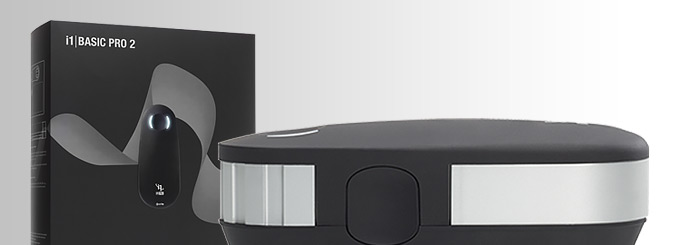
An important thing to consider for most users
is how a screen will perform out of the box and with some basic manual
adjustments. Since most users won't have access to hardware colorimeter tools,
it is important to understand how the screen is going to perform in terms of
colour accuracy for the average user.
We restored our graphics card to default
settings and disabled any previously active ICC profiles and gamma corrections.
The screen was tested at default factory settings using our new
X-rite i1 Pro 2
Spectrophotometer combined with
LaCie's Blue Eye Pro software suite. An X-rite i1 Display Pro colorimeter
was also used to verify the black point and contrast ratio since the i1 Pro 2
spectrophotometer is less reliable at the darker end.
Targets for these tests are as follows:
-
CIE Diagram - confirms the colour
space covered by the monitors backlighting in a 2D view, with the black triangle
representing the displays gamut, and other reference colour spaces shown for
comparison. Usually shown as a comparison against the common sRGB space
-
Colour space coverage volumes - we
also measure using a piece of software called ChromaPure the colour space
(gamut) volumes produced by the backlight in comparison to the sRGB, DCI-P3 and
Rec.2020 colour spaces. sRGB is the most commonly used colour space so it is
important to have a decent coverage from the screen here. If the colour space is
>100% sRGB then the screen can produce a wider colour gamut, often reaching
further in to the wider gamut DCI-P3 (commonly used for HDR) and Rec.2020
reference spaces.
-
Gamma - we aim for 2.2 which is the
default for computer monitors
-
Colour temperature / white point - we
aim for 6500k which is the temperature of daylight
-
Luminance - we aim for 120
cd/m2,
which is the recommended luminance for LCD monitors in normal lighting
conditions
-
Black depth - we
aim for as low as possible to maximise shadow detail and to offer us the best
contrast ratio
-
Contrast ratio
(static) -
we aim for as high as possible. Any dynamic contrast ratio controls are turned
off here if present
-
dE average / maximum
- we aim for as low as possible.
If DeltaE >3, the color displayed is significantly different from the
theoretical one, meaning that the difference will be perceptible to the viewer.
If DeltaE <2, LaCie considers the calibration a success; there remains a slight
difference, but it is barely undetectable. If DeltaE < 1, the color fidelity is
excellent.

Default Performance
and Setup
The U2719D comes factory calibrated in the
'standard' preset mode which is designed of offer reliable sRGB performance. It
is calibrated to a DeltaE <2 and also includes calibration for the white point
(at 6500k target) and for a 2.2 gamma curve. An individual calibration report is
included in the box. A copy of ours is shown below for example:
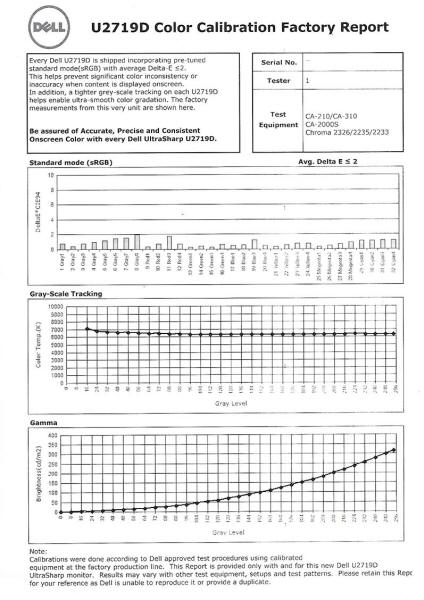
Default settings of the screen were as follows:
Dell
U2719D
Default Settings
(Factory Calibration)



|

 |
|
Monitor
OSD Settings |
|
|
Preset Mode |
Standard |
|
Brightness |
75 |
|
Contrast |
75 |
|
RGB |
n/a |
|
Luminance
Measurements |
|
|
luminance (cd/m2) |
240 |
|
Black Point (cd/m2) |
0.25 |
|
Contrast Ratio |
977:1 |
|
Colour
Space Measurements |
|
|
sRGB coverage |
100.8% |
|
DCI-P3 coverage |
74.3% |
|
Rec.2020 coverage |
53.3% |
|
|
Initially out of the box the screen was set
with the 'Standard' preset mode which carries the factory calibration. The
display was set with a fairly high 75% brightness which was too bright and
uncomfortable to use. You will want to turn that down. The colours felt a bit too
warm.
We went ahead and measured the default state
with the i1 Pro 2. The
CIE diagram
on the left of the image confirms that the monitors colour gamut (black
triangle) matches very closely to the sRGB colour space reference
(orange triangle). We measured using ChromaPure software a 100.8% sRGB gamut
volume coverage which corresponds to 74.3% of the DCI-P3 reference and 53.3% of the
Rec.2020 reference.
You may wonder where the "85% DCI-P3
coverage" specification comes from, and in fact this 'standard' preset mode is
providing an accurate sRGB emulation, cutting down the backlight's native gamut a
little. If you switch to the other preset modes like movie, game or even the
custom color mode, then the normal native gamut is provided. That equates to
~109% sRGB and about 80% DCi-P3 coverage. If you want to work with a more
closely matched sRGB colour space, and also make use of the factory calibration
then this 'standard' preset mode is provided and works very nicely.
|
|
Key
Quick Information Box
-
Default 'standard' preset carries factory calibration
-
Accurate
sRGB gamut emulation in 'standard' preset
-
Slight
extended gamut with 80% DCI-P3 coverage from other presets available
-
Decent
enough gamma
-
White
point too warm
-
Excellent dE in factory calibrated mode
|
|
Default gamma was recorded at 2.2
average with a small 1% overall deviance from the target which was not too bad as an
average. The
gamma curve was a bit off, being a bit too low in dark tones (down to 2.07) and
a bit too high in lighter tones (2.32). However this was pretty decent in the
factory calibrated mode, and this was good news as there's no gamma adjustment
controls available in the OSD menu. Any further corrections to gamma would need
to involve software level calibration using a colorimeter. White point was measured
at a too warm 5653k, being 13% out from our target despite supposedly being
factory calibrated to 6500k (according to the provided report).
Luminance at the default 75% brightness level
was recorded at a bright 240
cd/m2
which is too high for prolonged general use, you will need to turn that down.
The black depth was 0.25 cd/m2
at this default brightness setting, giving us a good, but not excellent static contrast ratio of
977:1 from the IPS-type panel.
Colour accuracy measurements here were
excellent thanks to the factory calibration, with an average dE of only 1.0
recorded. Testing the screen
with colour gradients showed smooth gradients with only minor gradation evident
in places. There was no sign of any colour banding which was good
news.

Calibration
We used the
X-rite i1 Pro 2
Spectrophotometer combined with the LaCie Blue Eye Pro software package to
achieve these results and reports. An X-rite i1 Display Pro colorimeter was used
to validate the black depth and contrast ratios due to lower end limitations of
the i1 Pro device.
Dell
U2719D
Calibrated
Settings
Native gamut, Custom Color mode
 

|

 |
|
Monitor
OSD Settings |
|
|
Preset Mode |
Custom Color |
|
Brightness |
24 |
|
Contrast |
75 |
|
RGB |
100, 98, 98 |
|
Luminance
Measurements |
|
|
luminance (cd/m2) |
123 |
|
Black Point (cd/m2) |
0.12 |
|
Contrast Ratio |
1023:1 |
|
Colour
Space Measurements |
|
|
sRGB coverage |
108.9% |
|
DCI-P3 coverage |
80.3% |
|
Rec.2020 coverage |
57.6% |
|
We initially carried out a calibration in the
'Custom Color' mode which gave us access to adjust the RGB channels on the
screen. This operates the screen at its native gamut, equating to about
109% sRGB coverage and so a little wider gamut than most typical screens. We
will also calibrate the screen in a moment in the 'Standard' preset mode for
those wanting to more closely and accurately match the sRGB colour space for any colour critical
work. Most people will be perfectly happy though leaving the screen in the
'custom color' mode as the slightly wider colour space is minimal. It
gives you a small boost to the colours and vividness of the screen but certainly
doesn't look oversaturated or anything. This 'custom color' mode will also give
you more flexibility to adjust the colour temperature via the OSD controls (RGB
settings) and help preserve contrast and tonal values during the calibration.
The OSD settings were
adjusted as shown in the table above, as guided during the calibration process
and measurements.
These OSD changes allowed us to obtain an optimal hardware starting point and
setup before software level changes would be made at the graphics card level. We
left the LaCie software to calibrate to "max" brightness which would just
retain the luminance of whatever brightness we'd set the screen to, and would
not in any way try and alter the luminance at the graphics card level, which can
reduce contrast ratio. These adjustments before profiling the screen would help
preserve tonal values and limit banding issues. After this we let the software
carry out the LUT adjustments and create an
ICC profile.
Average gamma had been reliable on average
out of the box, and after calibration in this mode we measured it at 2.2 average (0%
deviance) and levelling out the gamma curve nicely across the different
grey shades. The white point had now been corrected to 6521k which had fixed the
too warm 13% deviance we'd seen before in the default mode. Luminance had been
improved thanks to the adjustment to the brightness control and was now being
measured at a far more comfortable 123
cd/m2.
We measured
a black depth of 0.12 cd/m2 and this produced a static contrast ratio
of 1023:1. This was slightly improved over the default setup as well.
Colour accuracy of the resulting profile was excellent, with dE
average of 0.4 and maximum of 1.0. LaCie would consider colour fidelity to be
excellent.
Testing the screen with various colour
gradients showed smooth transitions with some minor gradation in darker
tones but no visible banding at all.
You can use our settings
and try our calibrated ICC profile if you wish, which are available in
our ICC profile database. Keep in mind that results will vary from one
screen to another and from one computer / graphics card to another.

Dell
U2719D
Calibrated
Settings
sRGB emulation, Standard mode
 

|
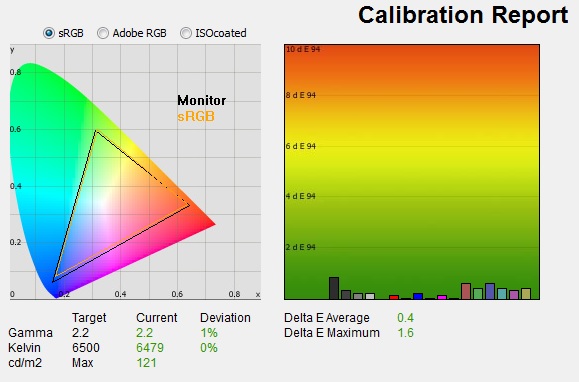
 |
|
Monitor
OSD Settings |
|
|
Preset Mode |
Standard |
|
Brightness |
35 |
|
Contrast |
75 |
|
RGB |
n/a |
|
Luminance
Measurements |
|
|
luminance (cd/m2) |
121 |
|
Black Point (cd/m2) |
0.15 |
|
Contrast Ratio |
824:1 |
|
Colour
Space Measurements |
|
|
sRGB coverage |
100.8% |
|
DCI-P3 coverage |
74.3% |
|
Rec.2020 coverage |
53.3% |
|
We also wanted to calibrate the screen in the
sRGB colour space emulation mode, probably useful for those wanting to work with
the slightly more accurate sRGB colour space and avoid any slight oversaturation
that the other modes might produce. We therefore left the screen in the
'standard' preset mode which we know carries this sRGB emulation. We did not
have access to adjust any of the RGB controls in this mode, so any corrections
to the colour temperature would be completed as part of the software profiling
and ICC profile creation. This would be needed to correct the overly warm
default (5653k) that we'd measured from the factory calibration. We were
actually only able to change the brightness control really in this calibration,
with the other adjustments being made by the profiling at the graphics card
level.
Average gamma had been reliable on average
out of the box, and after calibration in this mode we measured it at 2.2 average (leaving
a small 1%
deviance) and levelling out the gamma curve a bit better across the different
grey shades. The white point had now been corrected to 6479k which had fixed the
too warm 13% deviance we'd seen before. Luminance had been improved
thanks to the adjustment to the brightness control and was now being measured at
a far more comfortable 121
cd/m2.
We measured
a black depth of 0.15 cd/m2 and this produced a static contrast ratio
of 824:1. This had dipped a bit compared with the default factory state in this
mode (977:1) because of the need to adjust the colour temperature quite a lot at
the graphics card level. It was still a reasonable contrast ratio, on par with
many IPS and TN Film technology screens. Colour accuracy of the resulting profile was excellent, with dE
average of 0.4 and maximum of 1.6. LaCie would consider colour fidelity to be
excellent.
Testing the screen with various colour
gradients showed smooth transitions with some minor gradation in darker
tones and some very slight banding introduced through the graphics card corrections.
You can use our settings
and try our calibrated ICC profile if you wish, which are available in
our ICC profile database. Keep in mind that results will vary from one
screen to another and from one computer / graphics card to another.

Calibration
Performance Comparisons
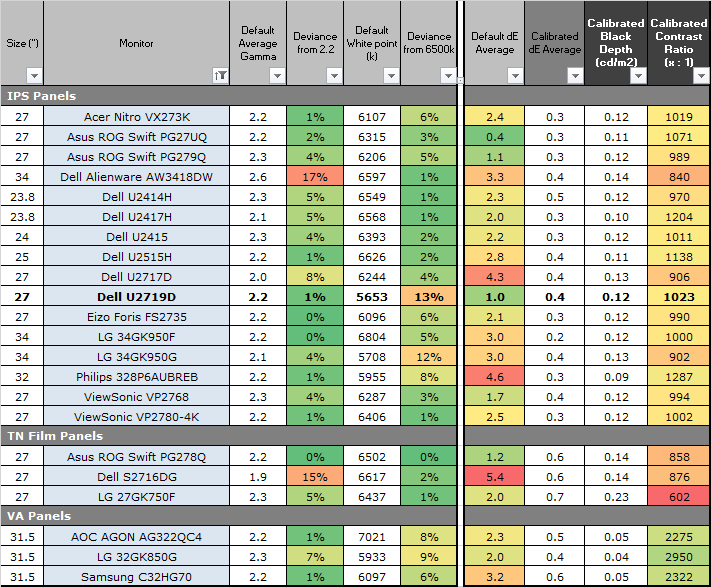
The comparisons made in this section try to
give you a better view of how each screen performs, particularly out of the box
which is what is going to matter to most consumers. We have divided the table up
by panel technology as well to make it easier to compare similar models. When
comparing the default factory settings for each monitor it is important to take
into account several measurement areas - gamma, white point and colour accuracy.
There's no point having a low dE colour accuracy figure if the gamma curve is
way off for instance. A good factory calibration requires all 3 to be well set
up. We have deliberately not included luminance in this comparison since this is
normally far too high by default on every screen. However, that is very easily
controlled through the brightness setting (on most screens) and should not
impact the other areas being measured anyway. It is easy enough to obtain a
suitable luminance for your working conditions and individual preferences, but a
reliable factory setup in gamma, white point and colour accuracy is important
and some (gamma especially) are not as easy to change accurately without a
calibration tool.
From these comparisons we can also compare
the calibrated colour accuracy, black depth and contrast ratio. After a
calibration the gamma, white point and luminance should all be at their desired
targets.
Default setup of the screen out of the box
in the factory calibrated 'standard' mode was overall good, with the only issue
being the too warm colour temperature. We had a decent average gamma of 2.2 (1%
deviance), a good IPS contrast ratio and a very low dE of 1.0. There was also an
accurate emulation of the sRGB colour space in this mode, cutting down the
slight over-coverage of the native gamut from the backlight.
The U2719D carried
a better out of the box default setup than its predecessor, the U2717D as you can see from the
table. Although things were closer between the two if you switched the U2717D to
its own factory calibration mode, instead of the default mode. That factory
calibration on the U2717D operated in the sRGB preset, and had a good gamma (0%
deviance) and white point (1% deviance) but showed a higher dE with average of
2.3. On that older model there was no sRGB emulation either, it would always
operate at the slightly extended ~109% sRGB coverage. Overall, the default setup
and factory calibration of the U2719D was better we felt.
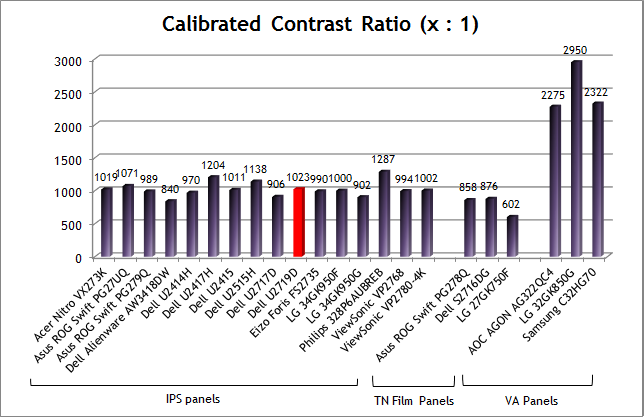
When it comes to black depth and contrast
ratio the screen performed well for an IPS panel at 1023:1 after calibration
(custom color mode). While we've seen a few recent IPS screens reach up a bit
higher around 1200:1, around 1000:1 is still good for an IPS panel. At 1023:1, this
new U2719D outperformed the last 27" UltraSharp model from Dell, the U2717D (906:1) as well
which was pleasing.
|
Check Pricing and Buy - Direct Links
|
|
Amazon
|
|
TFTCentral is a participant
in the Amazon Services LLC Associates Programme, an affiliate
advertising programme designed to provide a means for sites to earn
advertising fees by advertising and linking to Amazon.com, Amazon.co.uk,
Amazon.de, Amazon.ca and other Amazon stores worldwide. We also
participate in a similar scheme for Overclockers.co.uk. |

Viewing Angles

Above: Viewing angles shown from front and side, and from above and below.
Click for larger version
Viewing angles of the screen were very good
as you would expect from an IPS-type panel. Horizontally there was very little
colour tone shift until wide angles past about 45°. A slight darkening of the
image occurred horizontally from wider angles as you can see above as the
contrast shifted slighting. Contrast shifts were slightly more noticeable in the
vertical field but overall they were very good. The screen offered the wide
viewing angles of IPS technology and was free from the restrictive fields of
view of TN Film panels, especially in the vertical plane. It was also free of
the off-centre contrast shift you see from VA panels and a lot of the quite
obvious gamma and colour tone shift you see from some of the modern VA panel
type offerings.
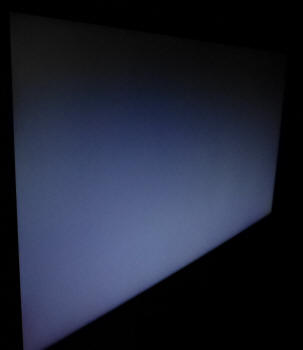
Above: View
of an all black screen from the sides. Click for larger version
On a black image there is a characteristic
pale glow introduced to the image when viewed from a wide angle, commonly
referred to as IPS glow. This type of glow is common on most modern IPS-type
panels and can be distracting to some users. If you view dark content from a
normal head-on viewing position, you may see this glow as your eyes look towards
the edges of the screen. The level of glow was fairly typical for an IPS-type
panel, and similar to the older
U2717D model. Not surprising of course given the same panel being used.

Panel Uniformity
We wanted to
test here how uniform the brightness was across the screen, as well as identify
any leakage from the backlight in dark lighting conditions. Measurements of the
luminance were taken at 35 points across the panel on a pure white background.
The measurements for luminance were taken using BasICColor's calibration
software package, combined with an X-rite i1 Display Pro colorimeter with a
central point on the screen calibrated to 120 cd/m2. The below
uniformity diagram shows the difference, as a percentage, between the
measurement recorded at each point on the screen, as compared with the central
reference point.
It is worth
noting that panel uniformity can vary from one screen to another, and can depend
on manufacturing lines, screen transport and other local factors. This is only a
guide of the uniformity of the sample screen we have for review.

Uniformity of Luminance

Luminance uniformity of the screen was moderate, with the upper and top left
regions of the screen showing the most deviance from our centrally
calibrated point. Along the upper edge the luminance dropped by around 15%
on average, in the most extreme case down to 99 cd/m2 in the
upper left corner (-21%). The lower right hand regions of the screen were
within a smaller deviance and showed an average 3% deviance from the central
point. Overall around 57% of the screen was within a 10% variation.

Backlight Leakage
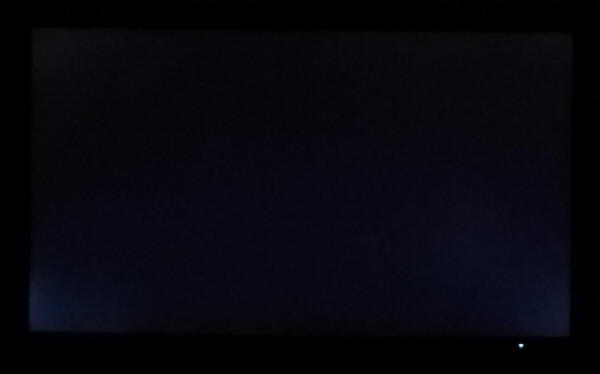
Above: All
black screen in a darkened room. Click for larger version
We also tested the screen with an all black
image and in a darkened room. A camera was used to capture the result. There was
some clouding evident from all four corners of the screen, with the bottom
corners being the most obvious. You could see this with the naked eye on an all
black image in a dark room, but in normal day to day use it caused no issues.
Note: if you want to test your own screen for
backlight bleed and uniformity problems at any point you need to ensure you have
suitable testing conditions. Set the monitor to a sensible day to day brightness
level, preferably as close to 120
cd/m2 as you can get it (our tests
are once the screen is calibrated to this luminance). Don't just take a photo at
the default brightness which is almost always far too high and not a realistic
usage condition. You need to take the photo from about 1.5 - 2m back to avoid
capturing viewing angle characteristics, especially on IPS-type panels where
off-angle glow can come in to play easily. Photos should be taken in a darkened
room at a shutter speed which captures what you see reliably and doesn't
over-expose the image. A shutter speed of 1/8 second will probably be suitable
for this.

General and Office Applications

This screen features a 2560 x 1440 WQHD
resolution, a significant step up from the wide range of 1920 x 1080 screens on
the market and a comfortable resolution for this size screen we feel. These
higher resolution 27" models offer a tighter pixel pitch of 0.233mm which
results in a smaller text size than common 24" 1080p screens, although it is
still a nice and comfortable size. We are very used to working with 27" 1440p
screens all the time and find them very comfortable and a significant upgrade
over 1080 / 1200p models. Some users may find the small text a little too small
to read comfortably, and we'd advise caution if you are coming from a smaller
screen for instance where the pixel pitch and text are normally larger. The
extra screen size takes some getting used to over a few days as there really is
a lot of room to work with but once you do, it's excellent. For those wanting a
high resolution for CAD, design, photo work etc, this is a really good option.
The image was very sharp and crisp and text was very clear.
With its
WQHD display, you enjoy 77% more desktop space than a full HD screen to spread
out your windows and palettes.
The ultra
thin bezel/border design around all 4 edges mean that the screen could be easily
integrated into a multi-screen set up if you wanted. The light AG coating
of the IPS technology panel is certainly welcome, and much better than the older
grainy and 'dirty' appearance of older IPS AG coatings. Although it's been
several years since those more grainy coatings were used. The
wide viewing
angles provided by this panel technology on both horizontal and vertical planes,
helps minimize on-screen colour shift when viewed from different angles.
The
default setup of the screen was good thanks to the factory calibration, with the
only real issue being the too warm colour temperature.
The
brightness range of the screen was very good, with the ability to offer a
luminance between 299 and 39 cd/m2. This should mean the screen is
perfectly useable in a wide variety of ambient light conditions, including
darkened rooms. A setting of ~31 in the OSD brightness control should return you
a luminance close to 120 cd/m2 out of the box. On another positive
note, the brightness regulation is controlled without the need for
Pulse Width Modulation (PWM), and so those who suffer from eye fatigue or
headaches associated with flickering backlights need not worry.
There was no
audible noise from the screen, even when conducting specific tests which can
sometimes cause issues. There's a 'ComfortView' preset mode available which is
designed for reading and office work and reduce blue light. This makes the image
much warmer and more yellow. There aren't any other additional low blue light
modes or anything on this model.
The screen offers 4x USB 3.0 ports which can
be useful. Two are located on the back of the screen a bit out of the way, but
there are 2 easy access ports on the left hand side of the screen which is
handy. One of each set has fast charging capabilities too. There are no further
extras like ambient light sensors, integrated speakers or card readers which can be useful in office
environments. Although there is an audio line out connection on the back. There was a
very good range
of ergonomic adjustments available from the stand allowing you to obtain a
comfortable position for a wide variety of angles. The VESA mounting support may also be
useful to some people as well.

Responsiveness and Gaming
|
Panel Manufacturer and
Technology |
Samsung PLS (IPS-type) |
|
Panel Part |
Labelled as
W270HIAP1 - (LTM270DL11) |
|
Quoted G2G Response Time |
5ms G2G (fast)
8ms G2G (normal) |
|
Quoted ISO Response Time |
n/a |
|
Overdrive Used |
Yes |
|
Overdrive Control
Available Via OSD Setting |
Response Time |
|
Overdrive OSD Settings |
Normal, Fast |
|
Maximum
Refresh Rate |
60Hz native |
|
Variable
Refresh Rate technology |
n/a |
|
Variable
Refresh Rate Range
|
n/a |
|
Blur
Reduction Backlight |
n/a |
The U2719D is rated by Dell as having a
5ms G2G typical response time in the 'fast' response time mode. A figure of 8ms
G2G is also quoted for the 'normal' mode. The screen uses
overdrive / response time compensation (RTC) technology to boost pixel
transitions across grey to grey changes as with nearly all modern displays.
The part
being used is
a Samsung PLS (IPS-type) technology panel. Have a read
about response time in our
specs section if you need additional information about this measurement.
We use an
ETC M526
oscilloscope for these measurements along with a custom photosensor device.
Have a read of
our response time measurement article for a full explanation of the testing
methodology and reported data.

Overdrive Setting

We carried out some initial response time
measurements in both of the overdrive settings, available in the OSD menu via
the 'Response Time' control.


In the 'normal' response time mode we
measured an average G2G response time of 9.1ms which was fairly decent for a
60Hz IPS-type panel. This was achieved with only very slight overshoot creeping
in on some transitions, but low enough that you couldn't see any artefacts from
it in practice.
If you switch up to the 'Fast' response time
setting the actual pixel response times were reduced significantly, down to
6.8ms G2G average now. In the best case they reached down to around 4.5ms as
well which was just under the product spec of 5ms G2G. However, this mode was unusable in practice as there were some extremely
high levels of overshoot introduced as a result of pushing those response times
so low. You get obvious pale and dark halos around moving objects and it just
isn't practical to use the screen in this mode. Given that low levels of
overshoot were starting to creep in at the 'normal' setting (with 9.1ms G2G
average measured), there's probably not much more to be improved with the
response times without the overshoot becoming a problem. Definitely stick to the
normal mode.

Detailed Response Time Measurements
Response Time setting = Normal
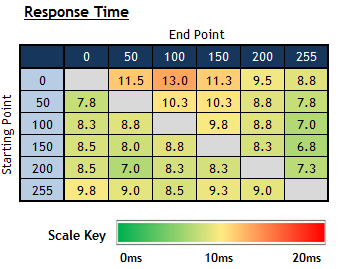
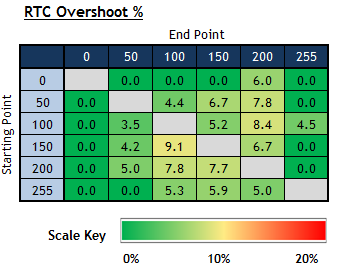
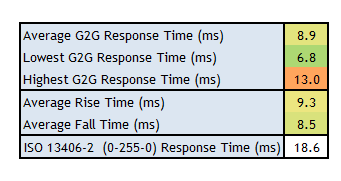
Having settled on the 'normal' response time
setting as the optimal on this model, we carried out some further measurements
at a wider range of pixel transitions to give us a fuller picture. We now had a
more accurate 8.9ms G2G average which was decent for a 60Hz IPS panel. In the
best cases we have seen 60Hz IPS models reach down to around 8.5ms without
overshoot becoming a problem, so the U2719D was a ever so slightly slower but not by
much. There were low levels of overshoot measured on many of the pixel
transitions but they were all low to moderate, and didn't seem to create any
noticeable issues in practice.

Gaming Comparisons
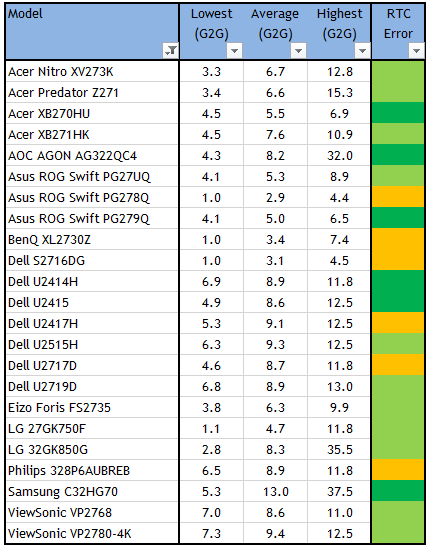
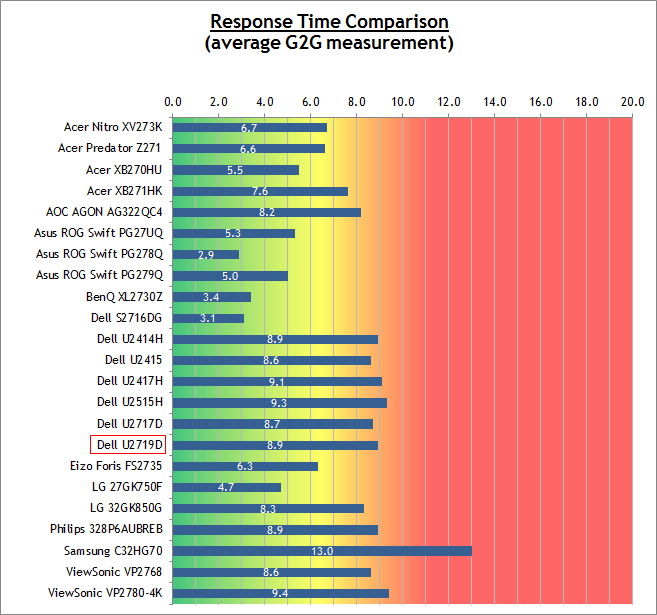
We have provided a comparison of the U2719D against many other screens
we have reviewed in a similar size range and technology.
The U2719D had improved things compared with the older U2717D we felt, and also
the response times were 0.2ms slower (not something you'd ever notice of course!)
the overshoot was quite a lot better and so had fewer issues with halos in
practice. This was a positive improvement with the latest generation of their
27" UltraSharp monitor as the overdrive impulse seems to have been toned
down slightly. The performance was pretty comparable to other 60Hz IPS
models shown here like the other Dell U models.

Additional
Gaming Features
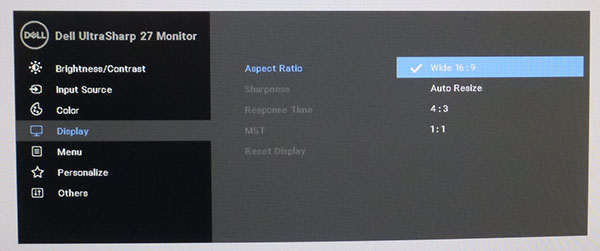
-
Aspect Ratio Control -
the screen has 4
settings for
hardware level
aspect ratio control. This includes options for 'wide 16:9', auto-resize, 4:3 aspect and 1:1
pixel mapping. This gives you a good level of flexibility for any external
input which might not operate at the native (and very common) 16:9 ratio.
-
Preset Modes -
There is a 'game' preset mode in
the menu which looked slightly more green than our calibrated 'custom color'
profile. Unfortunately you don't seem to be able to set different brightness
levels for each preset, so if you want to game at brighter settings you will
need to change that via the OSD brightness control, and then change it back to
something lower for your every day use.

Lag
We have written an in depth article about
input lag and the various measurement techniques which are used to evaluate
this aspect of a display. It's important to first of all understand the
different methods available and also what this lag means to you as an end-user.
Input Lag vs. Display Lag vs. Signal
Processing
To avoid confusion with different terminology
we will refer to this section of our reviews as just "lag" from now on, as there
are a few different aspects to consider, and different interpretations of the
term "input lag". We will consider the following points here as much as
possible. The overall "display lag" is the first, that being the delay between
the image being shown on the TFT display and that being shown on a CRT. This is
what many people will know as input lag and originally was the measure made to
explain why the image is a little behind when using a CRT. The older stopwatch
based methods were the common way to measure this in the past, but through
advanced studies have been shown to be quite inaccurate. As a result, more
advanced tools like SMTT provide a method to measure that delay between a TFT
and CRT while removing the inaccuracies of older stopwatch methods.
In reality that lag / delay is caused by a
combination of two things - the signal processing delay caused by the TFT
electronics / scaler, and the response time of the pixels themselves. Most
"input lag" measurements over the years have always been based on the overall
display lag (signal processing + response time) and indeed the SMTT tool is
based on this visual difference between a CRT and TFT and so measures the
overall display lag. In practice the signal processing is the element which
gives the feel of lag to the user, and the response time of course can
impact blurring, and overall image quality in moving scenes. As people become
more aware of lag as a possible issue, we are of course keen to try and
understand the split between the two as much as possible to give a complete
picture.
The signal processing element within that is
quite hard to identify without extremely high end equipment and very complicated
methods. In fact the studies by Thomas Thiemann which really kicked this whole
thing off were based on equipment worth >100,1000 Euro, requiring extremely high
bandwidths and very complicated methods to trigger the correct behaviour and
accurately measure the signal processing on its own. Other techniques which are
being used since are not conducted by Thomas (he is a freelance writer) or based
on this equipment or technique, and may also be subject to other errors or
inaccuracies based on our conversations with him since. It's very hard as a
result to produce a technique which will measure just the signal processing on
its own unfortunately. Many measurement techniques are also not explained and so
it is important to try and get a picture from various sources if possible to
make an informed judgement about a display overall.
For our tests we will continue to use the
SMTT tool to measure the overall "display lag". From there we can use our
oscilloscope system to measure the response time across a wide range of grey to
grey (G2G) transitions as recorded in our
response time
tests. Since SMTT will not include the full response time within its
measurements, after speaking with Thomas further about the situation we will
subtract half of the average G2G response time from the total display lag. This
should allow us to give a good estimation of how much of the overall lag is
attributable to the signal processing element on its own.
Lag Classification
To help in
this section we will also introduce a broader classification system for these
results to help categorise each screen as one of the following levels. We will
now keep these classifications consistent regardless of the actual refresh rate
of the screen being measured:
-
Class 1)
Less than 8.33ms - the equivalent to 1 frame lag of a display at 120Hz refresh
rate - should be fine for gamers, even at high
levels
-
Class 2)
A lag of 8.33 -
16.66ms - the equivalent of one to two frames at a 120Hz refresh rate - moderate lag but should be fine for many gamers.
Caution advised for serious gaming
-
Class 3)
A lag of more than
16.66ms - the equivalent of more than 2 frames at a refresh rate of 120Hz - Some noticeable lag in daily usage, not
suitable for high end gaming

For the full reviews of the
models compared here and the dates they were written (and when screens were
approximately released to the market), please see our
full
reviews index.
|
(Measurements in ms) |
On |
|
Total Display Lag
(SMTT 2) |
7.20 |
|
Pixel Response Time
Element |
4.45 |
|
Estimated Signal
Processing Lag |
2.75 |
|
Lag Classification |
1 |
|

Class
1 |
We have provided a comparison above against
other models we have tested to give an indication between screens. The screens
tested are split into two measurements which are based on our overall display
lag tests (using SMTT) and half the average G2G response time, as measured by
the oscilloscope. The response time is split from the overall display lag and
shown on the graph as the green bar. From there, the signal processing (red bar)
can be provided as a good estimation.
The total lag measured was 7.20ms. With
4.45ms of that accounted for by pixel response times, we can estimate around
2.75ms of signal processing lag, the actual lag you might feel during gaming and
other uses. This was next to nothing and in line with several other older Dell
UltraSharp models. We had measured a much higher lag from the U2717D model, so
there were some positive improvements here with the newer U2719D which was
pleasing.

Movies and Video
The following summarises the screens
performance for videos and movie viewing:
|
Category |
Display
Specs / Measurements |
Comments |
|
Size |
27" widescreen |
Fairly typical for a
desktop monitor nowadays and smaller than TV's by a lot |
|
Aspect Ratio |
16:9 |
Well suited to most common
16:9 aspect content and input devices |
|
Resolution |
2560 x 1440 |
Can support native 1080p
content, but not Ultra HD natively |
|
HDCP |
Yes |
Suitable for encrypted
content |
|
Connectivity |
DisplayPort 1.4 and HDMI |
Useful additional HDMI
input for external Blu-ray players or games consoles. |
|
Cables |
DisplayPort and HDMI |
Both provided in the box
which is good news |
|
Ergonomics |
Tilt, height, swivel,
rotate |
Very good range of
adjustments, also being easy to use. You should be able to position the screen
easily for multiple viewing
positions. |
|
Coating |
Light Anti-glare |
Provides clear, non-grainy
image and avoids unwanted reflections of full glossy solutions |
|
Brightness range |
39 - 299 cd/m2 |
Good adjustment range
offered. Flicker free backlight operation with no PWM |
|
Contrast |
1023:1 after calibration |
Decent IPS contrast ratio
which should be fine for most content. A VA technology panel would provide
you a higher contrast ratio if you watch a lot of dark content and miss some
shadow detail |
|
Preset modes |
Movie |
There is a Movie preset
mode which is cooler than our calibrated mode. Might be useful to some users |
|
Response times |
8.9ms G2G, no real
overshoot |
Response times are good for
a 60Hz IPS panel, with low levels of overshoot. Should be fine for movies |
|
Viewing angles |
Very good |
Thanks to the IPS panel
technology, suitable for viewing from a wide range of positions. IPS glow on
dark content could present a problem from some wider angles especially in
darker room conditions |
|
Backlight bleed |
No major bleed |
Some issue with backlight
bleed along the edges which can be a problem for movie viewing. Results may
of course vary from sample to sample. |
|
Audio |
Audio out |
No integrated speakers, but
an audio out connection |
|
Aspect Ratio Controls |
Wide 16:9, 4:3, auto resize
and 1:1 |
Good options to account for
non-16:9 format inputs if needed although the native aspect of the screen is
likely to be suitable for a lot of content |
|
PiP / PbP |
Not supported |
n/a on this model |
|
HDR support |
Not supported |
No local dimming or any
of the necessary elements to provide an HDR experience. There is a slight
boost in colours compared with a traditional sRGB screen, but only
creating 109% sRGB, equating to ~80% DCI-P3. |

Conclusion
If you
would like to help support our continued work please consider making a
donation
no matter how small or large. Thank you for the continued support.
As we've come to expect from Dell's
UltraSharp range, the U2719D was another solid choice, offering good all round
performance and some nice specs and features. We liked the sleek 4-side
borderless design and simple, but versatile stand. The 1440p resolution and
IPS-type panel were welcome as ever, providing an overall very nice picture
quality and great all round performance. Factory calibration was very good,
except for the slightly warm colour temperature. It was also quite useful to
include that more accurate sRGB emulation option via the 'standard' preset in
case you needed to more accurately match the sRGB colour space for colour
critical work. There was also a decent IPS contrast ratio, flicker free
backlight and wide viewing angles which helped provide a comfortable viewing
experience.
Not a huge amount has changed since the older
U2717D model in terms of features and design, but there have been a few
improvements to performance which was nice. The main difference was that Dell
had tidied up the moderate levels of overshoot from the older model here, as
long as you stick to the 'normal' response time mode, and also fixed the high
lag from its predecessor. So for those wanting to do a bit of casual gaming it
was a better choice than the older model. Of course it's not aimed at hardcore
gaming and lacks the high refresh rate, really low response times and
G-sync/FreeSync support of proper gaming displays.
If you're looking for a general all-round
display, with some great support and warranty as well then this is another great
outing from the Dell UltraSharp range. The U2719D is available from all main
regions via Amazon
(affiliate link) where you can check latest pricing and availability.
|
Pros |
Cons |
|
Solid all round
performance thanks to the IPS-type panel |
Typical IPS glow levels
maybe off-putting to some users |
|
Improved response times
and reduced lag compared with older U2717D model. Suitable for casual
gaming |
No major improvements
really over old U2717D but a few minor changes |
|
Good factory calibration
and colour performance |
Factory calibration
colour temp a little too warm |
|
Check Pricing and Buy - Affiliate Links
|
|
Amazon
|
|
TFTCentral is a participant
in the Amazon Services LLC Associates Programme, an affiliate
advertising programme designed to provide a means for sites to earn
advertising fees by advertising and linking to Amazon.com, Amazon.co.uk,
Amazon.de, Amazon.ca and other Amazon stores worldwide. We also
participate in a similar scheme for Overclockers.co.uk. |
|

|
TFT Central Awards Explained
We have two award
classifications as part of our reviews. There's the top 'Recommended'
award, where a monitor is excellent and highly recommended by us. There is
also an 'Approved' award for a very good screen which may not be perfect,
but is still a very good display. These awards won't be given out every
time, but look out for the logo at the bottom of the conclusion. A list of
monitors which have won our awards is available
here. |